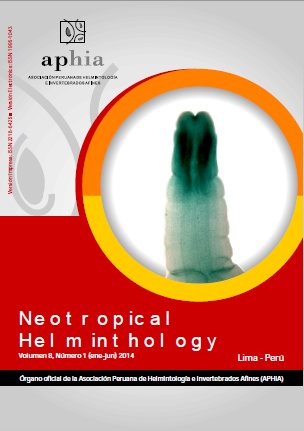A NEW SPECIES OF TRINIBACULUM (MONOGENEA: DACTYLOGYRIDAE) PARASITE OF THE GILLS OF ASTYANAX FASCIATUS (CUVIER, 1819) (CHARACIFORMES: CHARACIDAE) IN A NEOTROPICAL RIVER, SÃO PAULO STATE, BRAZIL
DOI:
https://doi.org/10.24039/rnh201481902Keywords:
Astyanax fasciatus, freshwater fish, identification key, Paranapanema river, phylogeny, taxonomy, Trinibaculum pinctiarum n. sp.Abstract
A new species of Monogenea - Trinibaculum pinctiarum n. sp. is described from the gills of Astyanax fasciatus known as "lambari do rabo vermelho", sampled in the Paranapanema River, Jurumirim reservoir, São Paulo State, Brazil. The new species is allocated to the genus Trinibaculum because it has a double ventral bar and dextro-lateral vagina. It is the second species (first species is Trinibaculum altiparanae) belonging to this genus that parasitizes the gills of the fish genus Astyanax. This monogenean is similar to T. altiparanae regarding the haptor structures and the bulbous distal vagina. However, Trinibaculum pinctiarum n. sp. differs in having: (1) coiled male copulatory organ, (2) accessory structure shaped as tweezers, (3) absence of postmedian process in the ventral bar, and (4) hooks with depressed thumb. The phylogenetic hypothesis of the genus Trinibaculum (Consistency index = 87%, Retention index = 80%, length = 16) based on 13 transformation series is (Trinibaculum rotundus, T. brazilensis, T. altiparanae, T. pinctiarum n. sp.). Such hypothesis corroborates current phylogenies of characiformes fishes. Moreover, this study includes a new identification key for the species of the genus Trinibaculum based in morphological characters.
Downloads
Published
How to Cite
Issue
Section
License
Copyright (c) 2021 Neotropical Helminthology

This work is licensed under a Creative Commons Attribution-NonCommercial-NoDerivatives 4.0 International License.
OBJETO: El AUTOR-CEDENTE transfiere de manera TOTAL Y SIN LIMITACIÓN alguna al CESIONARIO los derechos patrimoniales que le corresponden sobre la (s) obra(s) tituladas: xxxxxxxxxxxxxxxx, por el tiempo que establezca la ley internacional. En virtud de lo anterior, se entiende que el CESIONARIO adquiere el derecho de reproducción en todas sus modalidades, incluso para inclusión audiovisual; el derecho de transformación o adaptación, comunicación pública, traducción, distribución y, en general, cualquier tipo de explotación que de las obras se pueda realizar por cualquier medio conocido o por conocer en el territorio nacional o internacional.
REMUNERACIÓN: La cesión de los derechos patrimoniales de autor que mediante este contrato se hace será a título gratuito.
CONDICIONES Y LEGITIMIDAD DE LOS DERECHOS: El AUTOR-CEDENTE garantiza que es propietario integral de los derechos de explotación de la(s) obra(s) y en consecuencia garantiza que puede contratar y transferir los derechos aquí cedidos sin ningún tipo de limitación por no tener ningún tipo de gravamen, limitación o disposición. En todo caso, responderá por cualquier reclamo que en materia de derecho de autor se pueda presentar, exonerando de cualquier responsabilidad al CESIONARIO.
LICENCIA DE ACCESO ABIERTO: El AUTOR-CEDENTE autoriza que manuscrito publicado en La Revista Neotropical Helminthology permanece disponible para su consulta pública en el sitio web https://www.neotropicalhelminthology.com/ y en los diferentes sistemas de indexación y bases de datos en las que la revista tiene visibilidad, bajo la licencia Creative Commons, en la modalidad Reconocimiento-No comercial- Sin Trabajos derivados –aprobada en Perú, y por lo tanto son de acceso abierto. De ahí que los autores dan, sin derecho a retribución económica, a la Asociación Peruana de Helmintología e Invertebrados Afines (APHIA), los derechos de autor para la edición y reproducción a través de diferentes medios de difusión.


 Numero 2 Volumen 19 - 2025 (versión Anticipada)
Numero 2 Volumen 19 - 2025 (versión Anticipada)














































